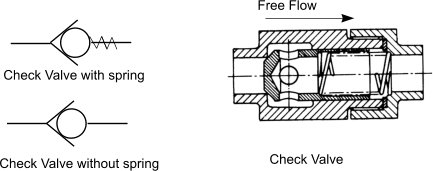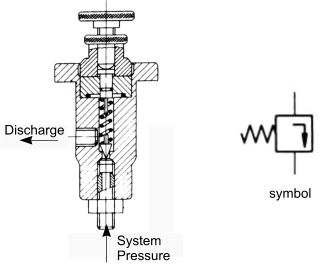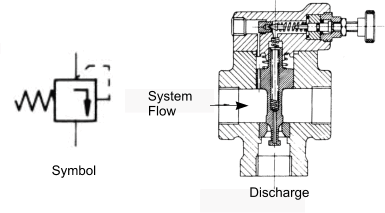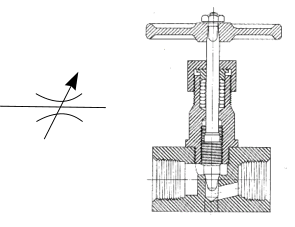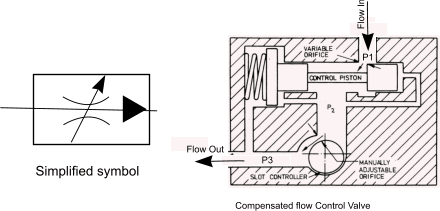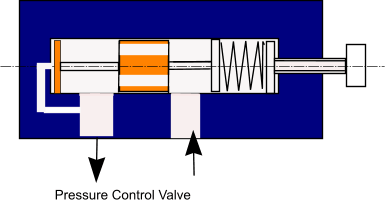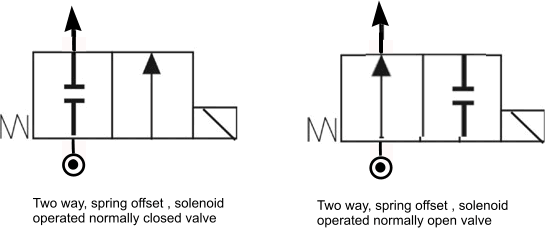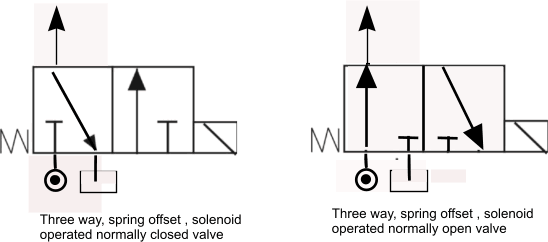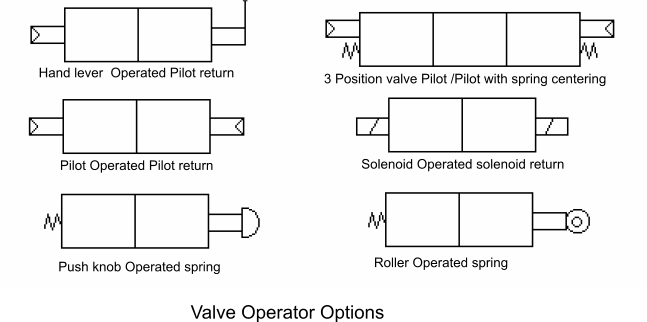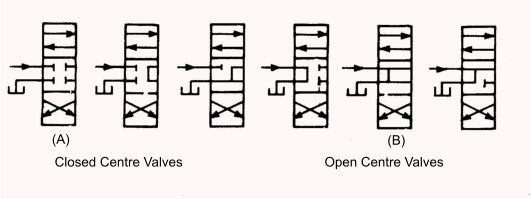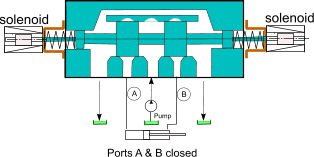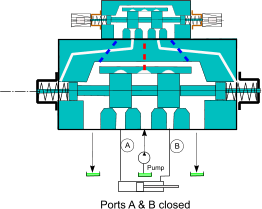Hydraulics Index
Hydraulic valves
|
Non-Return /Check Valves Relief Valves Flow Control valves |
Pressure Control Valves Direction Control Valve Electrohydraulic Servo Valves Pressure losses through Valves |
|
Introduction Today the control of the flow of fluid in hydraulic systems is by use of valves which are
generally manifold valves mounted on sub-plates. This largely eliminates piping between the valves.
The majority of the piping being between the valve manifolds and the pumps/ motors/ actuators. Non-Return /Check Valves / Check Valves are simply valves which provide reasonably unrestricted flow in one direction and stop the flow in the other direction. A light spring is generally used to retain the valve to a closed position on near zero flow. The valve shown is a poppet type valve
Relief Valves Relief valves are generally spring loaded valves which include a plug over a discharge port which is lifted against an spring force if the system pressure exceeds a certain value. This opens the flow to the discharge port relieving the pressure.
The pilot operated version enables more accurate control of the setting and a lower relief setting can be accommodated
Flow control valves Flow control valve can be non compensated or compensated. A non-compensated flow control valve is generally a simple needle valve. The control of the flow is simply by restricting the flow such that the pressure drop across the valve increases resulting in a reduced flow. However for hydraulic systems based on positive displacement pump any restriction in flow will cause a high rise in pressure which has to be limited by including a relief valve upstream of the flow control valve (see the figure below). A non compensated flow control valve will pass more flow if the pressure increases.
A pressure compensate flow control valve include a pilot valve which compensates for any system pressure increase to maintain the flow as constant.
Pressure Control Valves In a hydrostatic system the prime method of providing pressure control is be use of relief valves. However sometimes a sub-system is controlled at a lower pressure than the main system. This is achieved using a valve similar to the valve shown below. The valve is normally open supplying pressure to a sub- system . The outlet of the valve is connected to a pilot line which drive the valve closed against a spring if the outlet pressure reaches a set value
Direction Control Valves. Direction valves are the important hydraulic controls which enable the motion of an actuator to be started, stopped and reversed. There are three main types of directional control valves
sliding-plate valves - rotational and linear.
A significant advantage of spool valve is that spool movement is not affected by the fluid flow and pressure. The poppet valve can tend to open early at higher system pressures. The sliding valves is ,normally, not well suited to pressures higher than 80 barg . The primary disadvantage of spool valves is that for hydraulic applications they are designed with metal-to-metal sliding fits. Fluid may therefore bypass these seals. The valves are therefore not 100% positive shut-off valves and leakage flow means wasted energy. The notes below relate mainly to spool valves which are the most popular manifold mounted direction hydraulic valves in use today for pressures 100 to 350 barg.. The most basic direction control valve is the simple on off valve. A simple version is shown symbolically below.
The three way version of the above valve which allows the outlet port to be connected to either the pump or the reservoir is shown below
The valve can be operated using a number of options including manual, pilot, lever etc. A number of the valve operator options are shown symbolically below .
The sketch below illustrates a five way direction valve allowing full control of the motion of an actuated cylinder or motor. In the valve central position both outlet ports a closed providing some degree of locking of the actuator motion. The valve opererator is not shown.
The valve above is an example of a closed centre valve. Open centre valves are also available as shown below
A sketch showing a simple representation of a solenoid operated hydtraulic valve is shown below.
For high flow duties a simple solenoid does not have the force to actuate the larger spool required to control the larger flow. It is then necessary to use a pilot operated selonoid valve. This is simply a normal valve on which is mounted a small pilot valve . A simple representation of a pilot operated solenoid valve is shown below
Servo Control Valves. A servo valve is a direction control valve which includes spool positioning cababilities within its movement range. It therefore not only controls the direction of flow but the flow rate In a servo valve application the output flow or the velocity of the controlled actuator is measured and used as a feedback to control the position of the spool For example if the valve is controlling an hydraulic motor then if the speed of the motor is higher than required a signal is fed to the control system which reduces the signal to the valve which result in the flow being reduced. A servo valve can be used as part of an open loop control system which does not include a feedback loop with a poor relationship between the output flow and the driving signal, or a closed loop control system with a possible excellent relationship between the control signal and the and the output flow. Reference Basic Control There are two basic types of servo valves that are widely used. They are:
Mechanical-type servo valve The mechanical servo valve is generally a simple open loop valve with a lever controlling the valve spool position . The lever being driven by the position of a cylinder , a governer, or some othe mechanical device providing a feedback function. An electro-hydraulic servo valve is a very sophisticated control valve whose flow amplitude is directly proportional to the amplitude of its electrical DC input current. These valves are generally pilot operated spool valves. The pilot valves may be spool valves: flapper valves which control the pilot valve flow by moving a flapper against nozzles, jet pipes pilots which move jet over nozzles connected to the spool valves. It is recommended that reference to the links below is required to view the detailed design of electro- hydraulic servo valves. Pressure Losses in valves. It is very difficult to obtain values for the pressure losses in valves without referring to manufacturers literature.
For conventional needle valves and globe valves etc it is often possible to estimate the head losses using the flow factor Cv
or Kv. This website includes notes on this topic at this webpage Valves_flow Factor.
For normal hydraulic valves the manufactures literature must be referenced. |
Useful Links
|
|
Hydraulics Index
